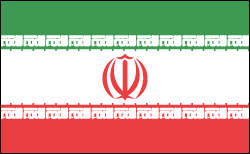Iran
| Next |
| Facts & Figures | |
|---|---|
Chief of State: Ayatollah Ali Khamenei (1989)
President: Mahmoud Ahmadinejad (2005)
Land area: 631,659 sq mi (1,635,999 sq km); total area: 636,293 sq mi (1,648,000 sq km)
Population (2011 est.): 78,868,711 (growth rate: 1.247%); birth rate: 18.52/1000; infant mortality rate: 41.11/1000; life expectancy: 70.35
Capital and largest city (2009 est.):Tehran, 7.19 million
Other large cities: Mashhad 2.592 million; Esfahan 1.704 million; Karaj 1.531 million; Tabriz 1.459 million
Monetary unit: Rial
|
Geography
Iran, a Middle Eastern country south of the Caspian Sea and north of the Persian Gulf, is three times the size of Arizona. It shares borders with Iraq, Turkey, Azerbaijan, Turkmenistan, Armenia, Afghanistan, and Pakistan.
The Elburz Mountains in the north rise to 18,603 ft (5,670 m) at Mount Damavend. From northwest to southeast, the country is crossed by a desert 800 mi (1,287 km) long.
Government
Iran has been an Islamic theocracy since the Pahlavi monarchy was overthrown on Feb. 11, 1979.
History
The region now called Iran was occupied by the Medes and the Persians in the 1500s B.C. , until the Persian king Cyrus the Great overthrew the Medes and became ruler of the Achaemenid (Persian) Empire, which reached from the Indus to the Nile at its zenith in 525 B.C. Persia fell to Alexander in 331–330 B.C. and a succession of other rulers: the Seleucids (312–302 B.C. ), the Greek-speaking Parthians (247 B.C. – A.D. 226), the Sasanians (224–c. 640), and the Arab Muslims (in 641). By the mid-800s Persia had become an international scientific and cultural center. In the 12th century it was invaded by the Mongols. The Safavid dynasty (1501–1722), under whom the dominant religion became Shiite Islam, followed, and was then replaced by the Qajar dynasty (1794–1925).
During the Qajar dynasty, the Russians and the British fought for economic control of the area, and during World War I, Iran's neutrality did not stop it from becoming a battlefield for Russian and British troops. A coup in 1921 brought Reza Kahn to power. In 1925, he became shah and changed his name to Reza Shah Pahlavi. He subsequently did much to modernize the country and abolished all foreign extraterritorial rights
Read more: Iran: Maps, History, Geography, Government, Culture, Facts, Guide & Travel/Holidays/Cities | Infoplease.com http://www.infoplease.com/ipa/A0107640.html#ixzz2ROg7rMvg



No comments:
Post a Comment